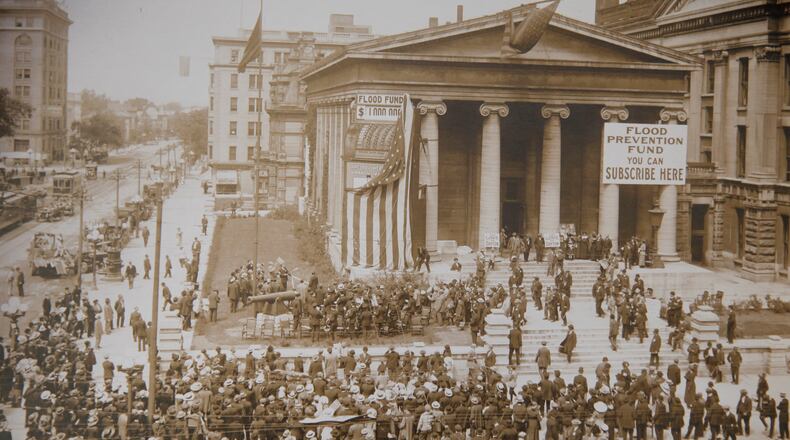Then on March 23, Easter Sunday, the rain began dumping 8 to 11 inches over a five-day period. Two days later, with the Great Miami River rising nearly two feet an hour, the levees failed.
Many stories of heroism emerged, with thousands of lives saved by brave citizens. Here are some of the people who stepped up when help was needed most, whose deeds were reported in the Dayton Daily News in the days afterward.
Ray Stansbury, an NCR employee, carried 22 people to dry land before getting caught in the high water. He was found later, unconscious in the water on Main Street. He was revived and fully recovered.
W.H. Snyder, chief engineer at the Schantz and Thomas plant, rescued 125 people after he “commandeered” a boat to bring people to high ground. Among those were a family of five who had spent 24 hours on the roof of a house.
Wilber J. Schneider, using “a big 16-foot row boat,” was able to take 300 to 400 people from their homes in high water to safety. Schneider said the most difficult part of the work was having to pass shrieking people, held prisoners by the water, as flames approached.
Fred Sheeley, an attendant at the state hospital, took at least 200 people from homes where they were in danger.
Louis Ross carried nearly 100 people to safety. He worked without taking a break, and refused to eat while people were in danger. One woman had a broken leg, and Ross used a fence picket as a splint and part of her skirt as a bandage.
Fred Oates, using one of the flat-bottom boats built at NCR, brought 10 or 12 people to safety. He also carried food to families stranded in the upper stories of their flooded homes.
E.J. Fryor rescued 80 people. Twin babies were born in his boat as the mother was being transported to safety.
Irwin Scholl rescued several families on East Third Street on the morning of the flood, using a gravel wagon. The water was nearly over the horses’ backs.
Alfred Swift Frank repeatedly crossed currents along streets in a canoe. Frank reportedly needed to be resuscitated several times but would return to the rescue efforts after regaining consciousness.
W.A. Hebble and a partner named Coy took more than 100 people from the south central part of the city to the Hickory Street school. The two worked when the water was the highest.
Robert Coppess, the football coach at Antioch College, was in charge of the relief train that brought seven boats to Dayton from Yellow Springs. Upon arriving, he joined the rescue effort and removed 75 people to safety.
Sherman Attick, a Stivers High School student, rescued more than 100 people. One time his boat overturned, but he grabbed a tree, righted the canoe and held two women and children until they could be rescued.
John Sloufman, working with a young man he didn’t know, spent 47 hours, drenched in rain, rescuing 386 people.
Mike O’Conner and M.L. Fruits hurried to Kilkare Park and secured 10 steel boats for rescue work and brought out between 300 and 400 people. They were able to get the boats to flooded areas by flagging down a CH&D train.
W.G Sloan and Frank Thompson rescued five members of the Kalor family, who had spent 48 hours on a raft. The Kalors were close to death, but were resuscitated by doctors in the neighborhood. The pair also brought food and supplies to people marooned at the Noyes Manufacturing Plant while the flooding was at its highest. Sloan and Thompson were credited with rescuing 307 people.
About the Author



